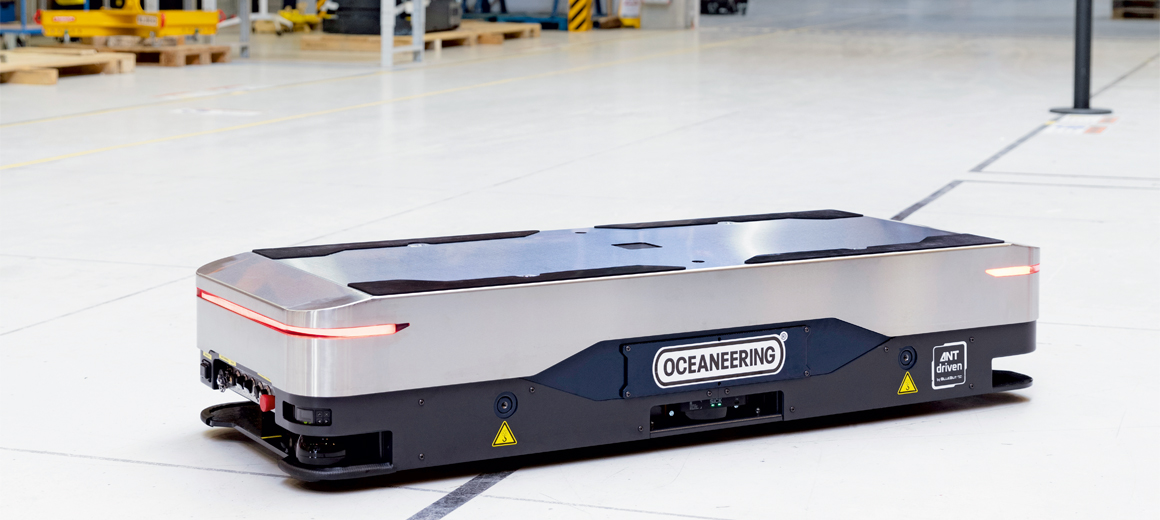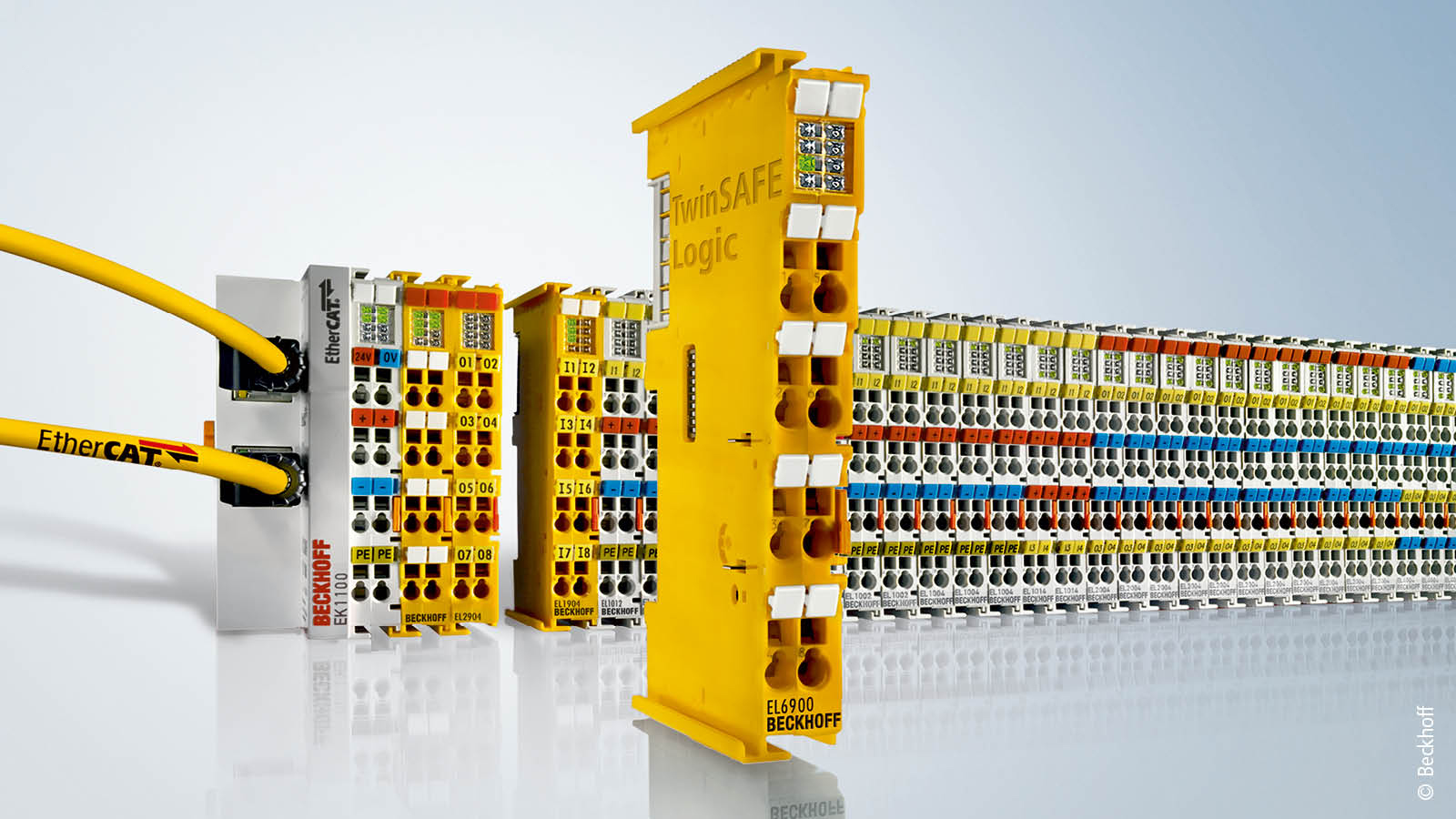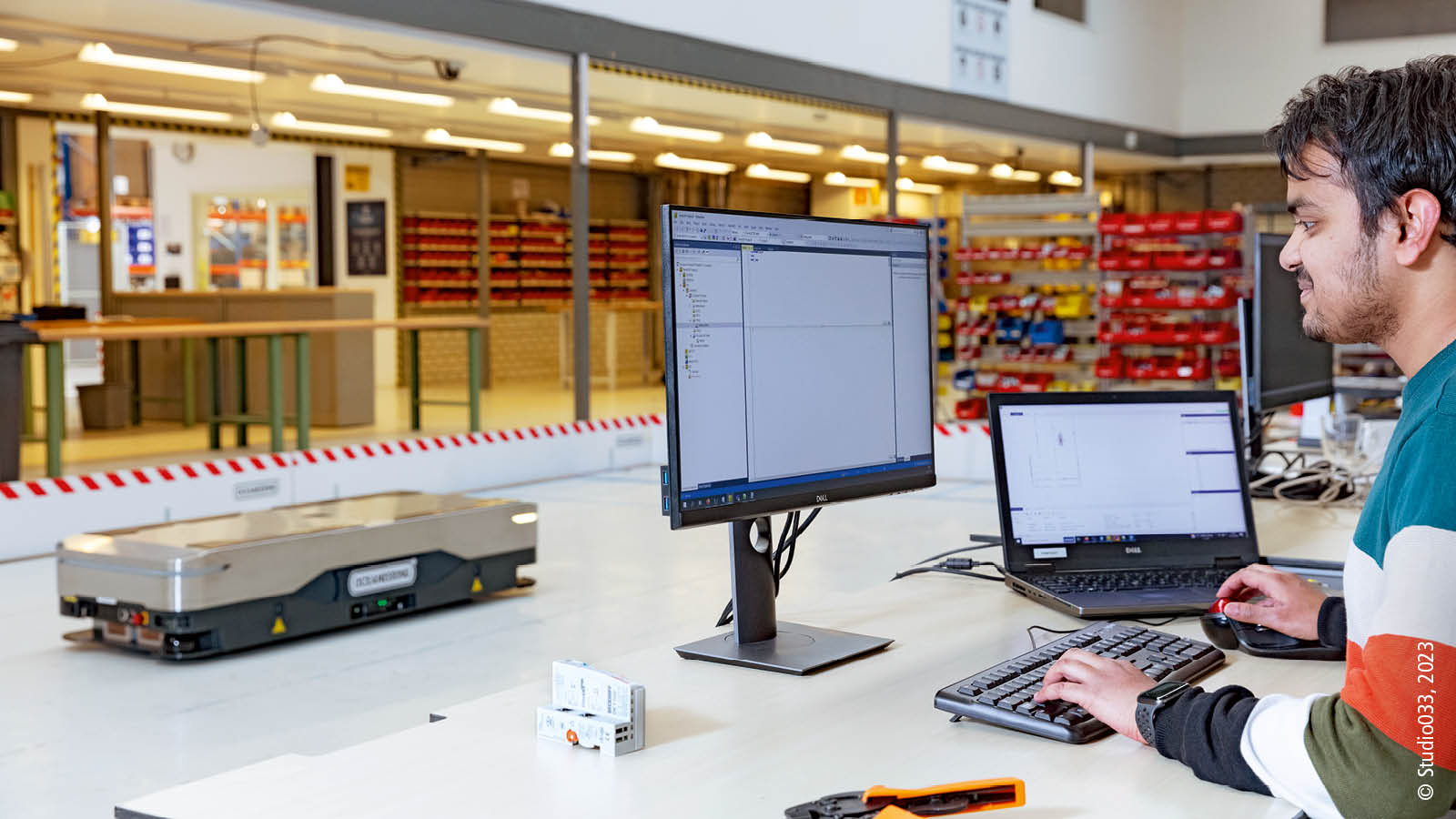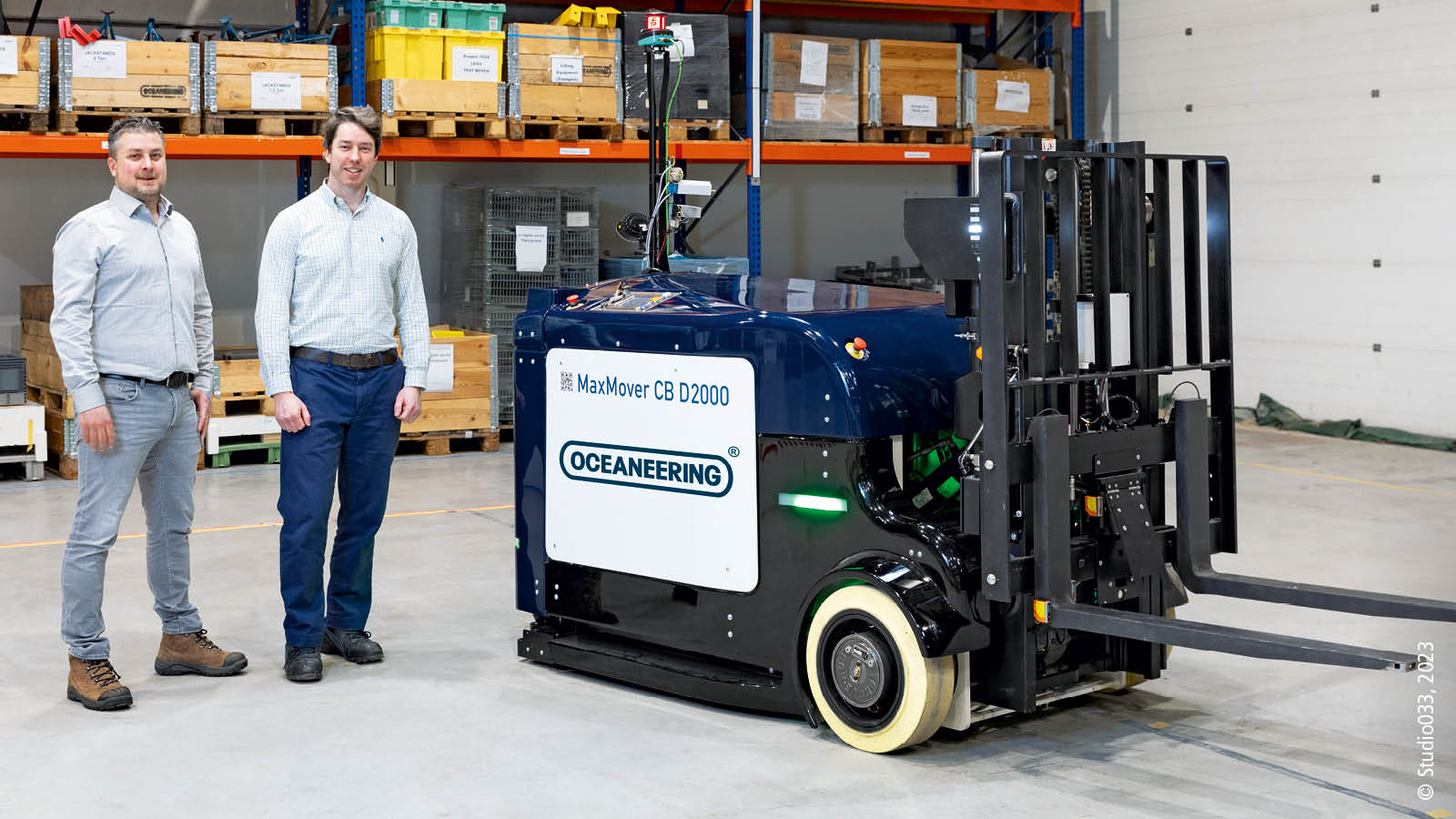

Ideal for industrial and medical facilities, the UniMoverTM O 600 system from Oceaneering Mobile Robotics moves ahead with powerful, space-saving automation technologies
What do intralogistics, aerospace, entertainment, offshore oil and gas, renewable energy, and scientific research have in common? First, applications in these industries all benefit from autonomous robot technology. Second, they’re all industries in which Oceaneering has pioneered innovative automated technology solutions.
Oceaneering Mobile Robotics (OMR) applies the company’s expertise in mobile robotics to material handling applications, according to Dr. Gareth Jones, Manager of Technology for OMR. The group has a rich history of deploying systems in manufacturing, hospitals, distribution, and automotive sectors, and has served some of the world’s most prestigious brands. The number of OMR mobile robots deployed across North America, Europe, Australia, and Asia has surpassed 1,700, which have collectively travelled 30 million miles. To maintain its impressive growth, OMR has focused on creating standard product lines to increase adoption in a host of new applications.

“Like many mobile robotics suppliers, we originally focused on bespoke solutions. But demand has grown across all industries, and we want to increase access to mobile robots,” Dr. Jones explains. “Now, instead of making a few dozen custom vehicles per year, we are focusing on producing hundreds of standardized products with a strong roadmap for releases – most recently the UniMover™ O 600.”
On the route to success
The UniMover™ O 600 is an underride mobile robot for light industrial and healthcare applications with extremely tight space requirements. It can reach speeds of 1.8 meters per second and handle heavy payloads up to 600 kilograms (1,322 pounds).
In industrial and hospital applications, the UniMover™ O 600 is a typically efficient and cost-effective transportation solution for picking up or dropping off good or materials, such as raw materials, food carts or laundry. The vehicle features omnidirectional motion and uses natural feature navigation with safety lidar to recognize and move safely through busy, unstructured environments. To accomplish this, the UniMover™ O 600 can operate in an autonomous mobile robot (AMR) mode, which provides optimal object avoidance while limiting speed, or AGV mode, which increases speed but essentially stops when objects are detected rather than maneuvering around them.
Beyond functionality and reliability, the OMR engineers needed to fit all control hardware into the smallest footprint possible, maintaining the vehicle’s compact dimensions of 1,670 by 600 by 335 millimeters (65.8 by 23.6 by 13.2 inches). They also had to develop manufacturing processes that would scale to support volume production of the standard solutions. In the past, they would program the vehicles and manufacturing equipment using Linux, and technicians tested products via Linux line command, according to Dr. Jones. Despite these inefficiencies, the team could not afford to completely scrap years’ worth of development.

OMR began evaluating automation vendors in 2021 based on functionality, but with an international team, the ability to collaborate and receive support globally was also critical. In just six months, Beckhoff was selected due to its high scores in both capabilities and usability.
Alternative OS offers flexibility for robotics
Each vehicle relies on a C6017 ultra-compact Industrial PC (IPC) from Beckhoff for control logic and other functionality. While Windows has long been the default for Beckhoff machine controllers, the C6017 on the UniMover™ uses the TwinCAT/BSD alternative operating system (OS). TwinCAT/BSD offers the performance and security of a modern UNIX-based OS. As such, it functions like today’s PLCs, which use a real-time operating system (RTOS) rather than proprietary firmware.
TwinCAT/BSD was a gamechanger for OMR, along with many other material handling specialists, according to Doug Schuchart, Global Intralogistics Manager at Beckhoff. “Unlike the ‘black box’ approach of traditional hardware PLCs, TwinCAT/BSD harnesses decades of sophisticated controls development at Beckhoff,” Schuchart says. “The powerful OS also remains open, allowing machines to run third-party software, such as Linux distributions, and it enables virtual machines in our new Hypervisor. Many applications benefit from the execution of third-party software alongside the PLC in the same hardware, either in the native OS or another OS in a virtual machine. AGVs, however, gain unique advantages using this architecture.”
TwinCAT 3 automation software remains the end-to-end engineering and runtime platform for TwinCAT/BSD applications. The OMR engineers enjoyed the ability to program in a variety of languages from the internationally standardized IEC 61131-3 and its object-oriented extensions to function blocks and computer science standards in its integration with Visual Studio™. “Our team is very happy with TwinCAT because they can build user interfaces, for example, for performing functional checks in a production line. This is much more intuitive than using command line in Linux,” Dr Jones says. “Plus, they can connect them to data coming off all the peripherals for greater visibility.”

EtherCAT ensures drivers’ safety in mobile robotics
The EtherCAT industrial Ethernet system offers real-time communication, along with free selection of topology and communication to all open protocols. OMR uses the EL6581 DMX master to control safety lights on the vehicle, and the EL6751 CANopen master streamlines communication with a third-party navigation controller. These modules also offer the compact, modular form factor of standard I/O cards.
Safety is critical for any autonomous robot, and TwinSAFE technology relies on Fail Safe over EtherCAT (FSoE), another international open standard, to enable high levels of safety. FsoE uses a “black channel” approach to communicate safety data over the standard EtherCAT network. This reduces cabling requirements, while providing the necessary redundancy for digital and analog safety TwinCAT also boosts safety capabilities through the ability to implement TwinSAFE applications using Safety C, in addition to standard safety logic.
The UniMover™ leverages a number of TwinSAFE terminals from Beckhoff. In particular, the EL5001-0090 1-channel SSI encoder interface simplifies monitoring of speed and position. “With the omnidirectional drive, we have to control two drive motors and two steering motors, so we need to know the positions of the steer angles and the actual speeds of the drive motors themselves,” Dr. Jones says. “The enhanced capabilities in TwinSAFE give us more options in the future as well, which will allow us to make even more sophisticated mobile robots.”
Compact controls move mobile robots full speed ahead
The viability of the UniMover™ O 600 comes down to size and maneuverability, Dr. Jones says, and standardizing on Beckhoff technologies helped in both aspects. The compact form factor of the C6017 reduced space requirements by 56% compared to OMR’s previous machine controller. The C6017 and EtherCAT Terminals saved time in addition to space. In the past, technicians had to spread components around the machine. Now, they make standard control kits ahead of time and install them in one enclosure on the UniMover™, speeding up commissioning times.
The New Automation Technology leader’s global sales network simplified collaboration with the OMR team, Schuchart explains: “The UniMover™ project provides a perfect example of our ability to collaborate internationally with customers. We work directly with Oceaneering’s engineers in Maryland and Florida, global purchasing in Louisiana, Gareth’s team in the Netherlands and global industry management to facilitate solid communication among all groups.”
OMR plans to further optimize production by switching to EJ series EtherCAT I/O modules, which mount on application-specific PCB boards and use standard connectors. At roughly 50% the size of standard I/O slices, EJ terminals are ideal for series production by eliminating labor time of traditional discrete wiring, which can add up in the production of large fleets of mobile robots. The solution provides engineers with the ability to create their own connectorized board in a highly streamlined matter using commercial-off-the-shelf (COTS) I/Os from Beckhoff.
Based on the UniMover™ O 600 project’s success, Oceaneering Mobile Robotics has continued to move ahead with powerful, space-saving automation technologies from Beckhoff for new vehicle systems: such as its MaxMover™ CB D 2000 counterbalance forklift. The MaxMoverTM replaces conventional forklifts, but even when fully loaded – with payloads over 4 tons – it can also operate in the AGV or AMR modes like the UniMover™,” Jones says. “Designing the UniMover™ was a challenging project” Jones says. “With the benefits gained through Beckhoff, we wanted to apply the same architecture across more of our standard mobile robotics lines.”